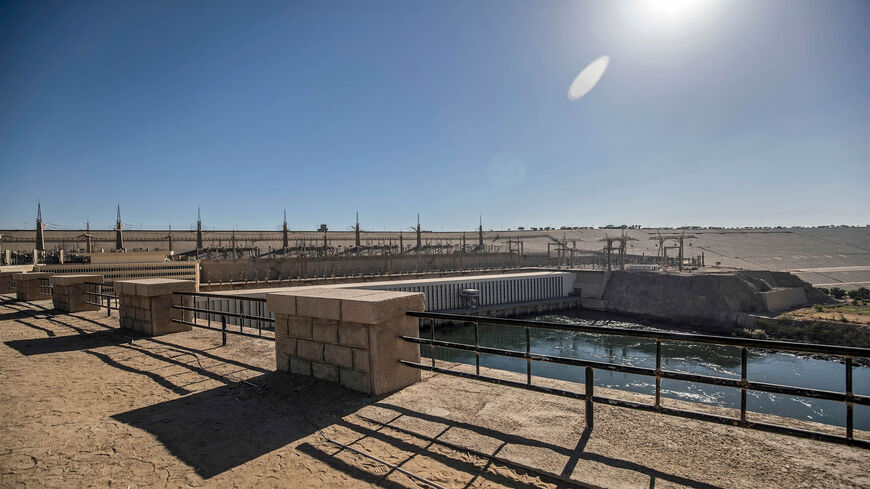Egypt’s Irrigation Ministry strives to collect the maximum amount of groundwater by installing “auto-control” devices in more than 15 underground wells.
Egyptian Minister of Water and Irrigation Mohamed Abdel Aty said that the ministry developed and increased the efficiency of its machinery and cranes in the New Valley governorate to ensure an immediate response to emergencies and periodic maintenance of the groundwater wells in the New Valley, so as to ensure their sustainability.
He said that for the first time 15 auto-control devices were recently installed in the groundwater wells in New Valley, and another four devices are being installed in four other wells. He noted that a joint cooperation protocol was signed between the Water Resources and Irrigation Ministry and the New Valley governorate for the installation of monitoring and control devices in 19 wells, so as to monitor and operate them automatically and remotely from a central operating room. The goal is to monitor safe withdrawals from wells, calculate consumption rates from each and avoid excessive withdrawal of water, in a bid to ensure a quick and accurate collection of data and to make them available to decision-makers so as to preserve and rationalize utilization of water resources.
Abdel Aty stressed the need to fully adhere to all regulations and requirements for the use of groundwater that would allow an optimal management and rational use of water resources, particularly since the deep groundwater in Egypt is nonrenewable.
He pointed to the importance of solar energy in the operation of wells as part of the measures taken to reduce emissions and control withdrawal rates from the aquifer, as well as shifting toward the use of modern irrigation systems as an alternative to flood irrigation that leads to optimal water uses and achieve optimal management of groundwater.
Speaking to Al-Monitor by phone, Ayman al-Sayed, head of the telemetry sector at the Ministry of Water Resources and Irrigation, said that the new water control system involves all licensed groundwater wells, whose license specifies the type of pump it will operate on and the number of operating hours per day, as well as a water meter for each well. They all depend on the well capacity, as well as the type of crop it will irrigate.
He said that these techniques aim to prevent excessive withdrawals from the aquifer, allowing sustainability of its operation, and preserving the groundwater reserve. Sayed stressed that this automatic mechanism prevents exceeding the daily withdrawal limit specified in the well’s license, which when reached, the power supplied to the well will be cut off so as to halt water pumping.
He explained that any institution or company willing to draw groundwater must obtain the ministry’s approval, and based on a study, the number of wells, operating hours and the amount of water that will be drawn out of the wells will be determined, in a bid to ensure the aquifers’ sustainability. He noted that any violations would be immediately stopped.
Sayed added that a hygrometer was used in several locations in the New Valley, and was connected to the control system that transfers the hygrometer data to farmers immediately via text messages on cellphones, to enable them to determine the optimal time to start and end the irrigation process. This helps increase the efficiency of the irrigation process, optimize the use of water and energy, improve the quality of crops and ensure full control of the water system by connecting the agricultural lands’ irrigation system to the underground wells’ operation system.
The ministry signed a cooperation protocol with the New Valley governorate, with the goal of installing monitoring and control devices for 19 wells, to ensure they are monitored and being operated automatically and remotely, through a central operating room.
Mohamed Ghanem, official spokesman for the Ministry of Water Resources and Irrigation, told Al-Monitor that groundwater in Egypt is nonrenewable, given that the underground reservoirs are not filled with rainwater, and therefore any amount drawn out will not be compensated, which requires a great deal of management.
He noted that Egypt is unable to renew its water resources when the underground reservoirs are depleted, particularly since Egypt is a dry country, and the volume of rain does not exceed 1 billion cubic meters a year. Therefore, there are strict standards for dealing with groundwater aquifers.
The Irrigation Ministry had taken several measures to deal with heavy rains and torrential rains that hit the governorates of northern and southern Sinai, the Red Sea, Marsa Matrouh and Assiut between Dec. 31 and Jan. 2. The report underlined the important role of the ministry to protect the population and facilities from the destructive effects of the floods, according to a statement published on the ministry’s website.
In the statement, Abdel Aty said that the protection works resulted in harvesting about 2.340 million cubic meters of rainwater, which can be used for drinking and grazing purposes.
Abbas Sharaki, professor of geology and water resources at Cairo University, told Al-Monitor that the measures the minister has been taking serve as a guide for people to rationalize water consumption and feel involved in the real problems on the ground.
He said that efforts are made in Egypt to preserve water in order not to waste what the country has in light of the existing challenges.
Egypt's 2021 Human Development Report, which was issued by the Ministry of Planning and Economic Development, in cooperation with the United Nations Development Program, explained that the filling of the Grand Ethiopian Renaissance Dam is expected to have a serious impact on the availability of water in Egypt, and will reduce the per capita water share and thus affect various economic activities, especially when Ethiopia unilaterally fills the dam's reservoir.






